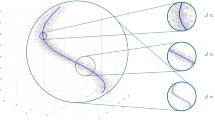Abstract
IN practice, the industrial psychologist is frequently faced with the situation in which he has to choose, from a trial test battery of say ten or more tests, those which will prove most effective in the selection of personnel according to some given criterion. He must then seek for answers to the following questions: (a) What is the individual validity of each test as judged by the criterion? (b) What combination of tests will give the best basis for prediction according to the criterion? (c) What will be the predictive value of such a combination? (d) How few tests may be used to obtain a validity coefficient the value of which does not depart appreciably from the theoretically best figure? (e) In what simple proportions must the scores of the chosen tests be weighted to obtain a close approximation to the best value of the joint validity coefficient?
This is a preview of subscription content, access via your institution
Access options
Similar content being viewed by others
References
Phil. Trans. Roy. Soc., A, 200, 1 (1902).
"Textbook of Statistical Method", 291–310 (1923).
"Factors of the Mind", 81, 88 and refs. (1940).
Holzinger, "Statistical Methods for Students in Education", 309.
Garrett, "Statistics in Psychology and Education" (2nd edition), 438–39.
Rights and permissions
About this article
Cite this article
NAYLOR, G. Estimation of Multiple Correlation by Means of Stereographic Projection. Nature 156, 58–59 (1945). https://doi.org/10.1038/156058a0
Issue Date:
DOI: https://doi.org/10.1038/156058a0
This article is cited by
-
Use of Stereographic Projection for Statistical Problems
Nature (1945)
Comments
By submitting a comment you agree to abide by our Terms and Community Guidelines. If you find something abusive or that does not comply with our terms or guidelines please flag it as inappropriate.



